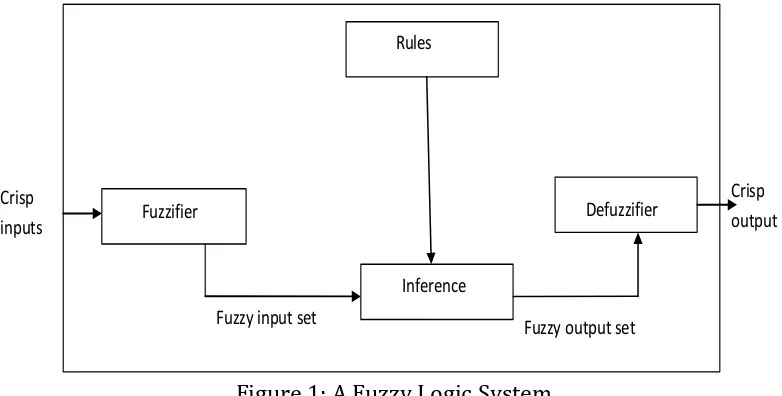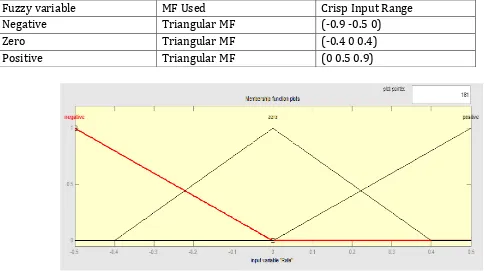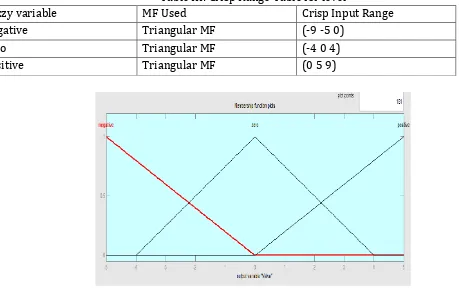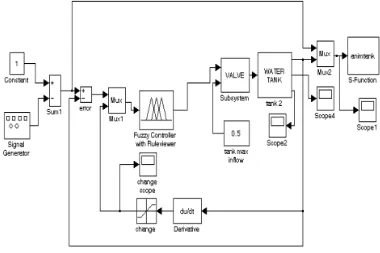© 2015, IRJET ISO 9001:2008 Certified Journal Page 1382
WATER LEVEL MONITORING AND CONTROL USING FUZZY LOGIC SYSTEM
Ihedioha Ahmed C. and Eneh Ifeanyichukwu I.
Enugu State University of Science and Technology Enugu, Nigeria
---Abstract: This study is on water level monitoring and control using fuzzy logic. There are various approaches to the design of the level controllers. The Proportional Integral Derivative (PID) controllers have turn out to be famous for level control. But at low power operations, Proportional-Integral-Derivative (PID) controllers cannot maintain liquid level properly, thus, the need for performance improvement in the existing liquid level regulators became paramount. In this research, a controller based on fuzzy logic was implemented. Fuzzy Logic Controller is easy to implement than PID controller. Additionally, the Fuzzy Logic Controller can be easily programmed into many currently available industrial process controllers. Unlike the conventional PID controller the Fuzzy Logic Controller has benefits on the system response. The Fuzzy Logic Controller on a level control problem with promising results can be applied to an entirely different industrial level controlling apparatus.
Keywords: Fuzzy Logic, PID, MATLAB and SIMULINK, Liquid, Control
I. INTRODUCTION
Many engineering applications are concerned with level control. It maybe a single loop level control or multi-loop level controls [1]. The process industries such as refineries petrol, petro-chemical industries, paper making and water treatment industries require liquids to be pumped, stored in tanks, and then pumped to another tank. There are various approaches to the design of the liquid level controllers. Among them, the Proportional Integral Derivative (PID) controllers have turn out to be famous for liquid level control. Proportional-Integral-Derivative (PID) controllers can be designed to sustain the level of liquid flow, but the limitation is its feedback type controller that is after the output is affected by error that the controller will take control action. Also, it doesn’t recognize the unanticipated alteration in the set point and thus, the transitory performance of the Proportional-Integral-Derivative (PID) controllers system is oscillatory [2]. Conventional control approaches are not convenient to solve the complex issues in this highly Non-linear system. To overcome the difficulties innate in controlling liquid level, a controller based on fuzzy logic was employed.
© 2015, IRJET ISO 9001:2008 Certified Journal Page 1383
Fuzzy logic is a form of knowledge representation appropriate for ideas that cannot be defined exactly, but which depend upon their contexts. It is a means of computing with expressions rather than numbers. It enables computerized devices to reason more like humans, and imitates the capability to reason and use estimated data to find answers [3]. It also permits control engineers to competently build up control strategies in application areas noticeable by low order dynamics with weak nonlinearities. It offers a wholly special approach to solve control problem. This method focuses on what the system should do rather than trying to understand how it works. Fuzzy logic controller (FLC) based on fuzzy logic provides a means of converting a linguistic control strategy based on expert knowledge into an automatic control strategy. It is a means of controlling with sentences rather than equations. It can be applied for the control of liquid flow and level in any processes [4]. They are known for their ability to provide very good control of a system that is both nonlinear and time varying. Fuzzy logic models interpret the human actions and are also called intelligent systems.
It has advantages of robustness, since it does not require precise, noise-free inputs and degrade gradually when system components fail like if a feedback sensor quits or is destroyed. It can be easily combined with conventional and allied control techniques, it can be modified easily to add, improve or alter system performance. Because of the rule-based operation, system can be easily designed for any reasonable number of inputs and outputs.
2.0 BACKGROUND REVIEW
© 2015, IRJET ISO 9001:2008 Certified Journal Page 1384
fuzzy logic for water level control in boiler drum and combustion quality control. The control system can efficiently reduce the uncertain disturbances from real environment. Recently, Shome and Ashok [9] described an intelligent controller using fuzzy logic to meet the nonlinearity of the system for accurate control of the boiler steam temperature and water level. Fuzzy Logic control has been rapidly gaining popularity among practicing engineers.
3.0. FUZZY LOGIC SYSTEMS
Fuzzy logic is a part of artificial intelligence or machine learning which interprets a human’s actions. Fuzzy techniques have been successfully used in control in several fields. Fuzzy logic is a form of logic whose underlying modes of reasoning are approximate instead of exact.
Fig. 1 illustrates a fuzzy logic system that is extensively used in fuzzy logic controllers. The general idea about fuzzy logic is that it takes the inputs from the sensors which is a crisp value and transforms it into membership values ranging from 0 to 1. It contains four major components; fuzzifier, rules, inference engine and defuzzifier.
A. Fuzzification
In fuzzy control theory, an input variable is converted into a fuzzy variable by a process known as fuzzification. Each fuzzy variable consists of a group of fuzzy sets.
The information fuzzification consists in fuzzy values assumption of input measures, respectively output in/from controller. Fuzzification is the process of making a crisp quantity fuzzy. The fuzzification interface involves the following functions:
i) Measures the value of input variables;
(ii) Performs a scale mapping that transfers the range of values of input variables into corresponding universes of discourse; and
iii) Performs the function of fuzzification that converts input data into suitable linguistic values which may be viewed as labels of fuzzy sets.
B. Fuzzy rules
© 2015, IRJET ISO 9001:2008 Certified Journal Page 1385
Fuzzy logic systems store rules as fuzzy associations; i.e. for the rule IFA THEN 5, where A and B are fuzzy sets, a fuzzy logic system stores the association (A,@ in a matrix M). The fuzzy associative matrix M maps fuzzy set A to fuzzy set B. This fuzzy association or fuzzy rules is called a fuzzy associative memory (FAM).
C. Fuzzy Inference
Fuzzy inference is the kernel in a fuzzy logic system. It has the capability of simulating human decision making based on fuzzy concepts and of inferring fuzzy control actions employing fuzzy implication and the rules of inference in fuzzy logic. In the fuzzy inference engine, fuzzy logic principles are used to combine fuzzy 'IF-THEN' rules from the fuzzy rulebase into a mapping from fuzzy input sets to fuzzy output sets.
D. Defuzzification
The defuzzification interface performs the following functions:
(i) Scale mapping which converts the range of values of output variables into corresponding universes of discourse; and
(ii) Defuzzification, which yields a nonfuzzy control action from an inferred fuzzy control action.
Defuzzifier produces a crisp output for our fuzzy logic system from the fuzzy set that is the output of the inference block.
Fuzzy output set Rules
Fuzzy input set
Inference
Fuzzifier Defuzzifier
Crisp inputs
[image:4.612.108.499.392.590.2]Crisp output
Figure 1: A Fuzzy Logic System.
3.1. Types of fuzzy logic systems
There are two major types of control rules in fuzzy control. They are:
A. Mamdani System
© 2015, IRJET ISO 9001:2008 Certified Journal Page 1386
B. Takagi- Sugeno
This method is mathematically competent and works well with optimization and adaptive techniques, which makes it very attractive in control problems, particularly for dynamic non-linear systems. The difference between Mamdani-type FIS and Sugeno-type FIS is the way the crisp output is generated from the fuzzy inputs. While Mamdani-type FIS empolys defuzzification of a fuzzy output, Sugeno-type FIS employs weighted average to compute the crisp output. The expressive power and interpretability of Mamdani output is lost in the Sugeno FIS since the consequents of the rules are not fuzzy [10]. But Sugeno has better processing time because the weighted average replaces the time consuming defuzzification process. Due to the interpretable and intuitive nature of the rule base, Mamdani-type FIS is widely used in particular for decision support application. Other differences are that Mamdani FIS has output membership functions whereas Sugeno FIS has no output membership functions. Mamdani FIS is less flexible in system design in comparison to Sugeno FIS.
3.2. Benefits of fuzzy logic
Major benefits of fuzzy logic approach over the other methods are:
a. Fuzzy logic posses the ability to mimic the human mind to effectively employ modes of reasoning that is approximate rather than exact.
b. Fuzzy Logic can model nonlinear functions of arbitrary complexity to a desired degree of accuracy. c. Perform better than the conventional PID controllers.
d. Fuzzy Logic is a convenient way to map an input space to an output space. Fuzzy Logic is one of the tools used to model a multi-input, multi-output system.
e. It is simple to design and implement.
f. Fuzzy logic is conceptually easy to understand. g. Fuzzy logic is flexible.
h. Fuzzy logic is tolerant of imprecise data.
i. Fuzzy logic can be built on top of the experience of experts. j. Fuzzy logic can be blended with conventional control techniques. k. Fuzzy logic is based on natural language.
3.3. Fuzzy controller
© 2015, IRJET ISO 9001:2008 Certified Journal Page 1387
quantization interval of the input domain into a very low-low resolution quantization interval of the output domain. As there are a few fuzzy quantization intervals covering the input domains, the mapping relationship can be very easily expressed by using the IF-THEN formalism. (In some applications this leads to a simpler solution in less designing time.) The overlapping of these fuzzy domains and their usually linear membership functions will eventually allow a rather high-resolution I/O function between crisp input and output variables to be achieved. Mamdani's development of fuzzy controllers in 1974 [11] gave rise to the utilization of these fuzzy controllers in ever-expanding capacities [12]. Figure2 shows the basic configuration of fuzzy logic controller.
DEFUZZIFICATION INTERFACE DECISION MAKING LOGIC FUZZIFICATION INTERFACE KB ACTUAL CONTROL FUZZY PROCESS OUTPUT
& STATE CONTROLLED
SYSTEM (PROCESS)
FUZZY
Figure2: Basic configuration of fuzzy logic controller
3.4. Classification of Liquid Level Controllers
There are several types of level controllers. Some of these are: A. Level Controllers
Level controllers are devices that operate automatically to regulate liquid or dry material level values. There are three basic types of control functions that level controllers can use, limit control, linear control and advanced or nonlinear control [13].
B. Integrated motion controllers
Integrated motion control systems contain matched components such as controllers, motor drives, motors, encoders, user interfaces and software. The manufacturer optimally matches components in these systems. They are frequently customized for specific applications.
Pump Controllers
C. Pump controllers manage pump flow and pressure output. D. Flow controllers
© 2015, IRJET ISO 9001:2008 Certified Journal Page 1388
3.5. Modeling equations
By applying the laws of physics to get a mathematical model of the system to become the dynamic equation of the system, as in equations (1)&(2).
= – ……1
= ……..2
Where F=steady-state liquid flow rate, cm3/sec.
R1 and R2 = coefficients, cm2.5/sec.
h1 and h2 = level of tanks, cm
A1 and A2 = the cross sectional area of tanks, cm2.
4.0 SYSTEM SIMULATION
4.1. Simulation Model of PID Controller
Simulation model of Conventional PID Controller for liquid level control as shown in Figure 9. In this we control the water level of the system with the help of PID controller in the MATLAB simulation. Two inputs are given in the valve these are control and source flow with an limited integrator the control valve is connected to the PID controller for controlling the outflow and a constant is connected to the valve source flow for controlling the level the output of valve is given to the water tank at which we observe the liquid flow out, water level and over flow.
© 2015, IRJET ISO 9001:2008 Certified Journal Page 1389
4.2. Designing of Fuzzy Logic Controller
A. FIS Editor
[image:8.612.25.523.543.614.2]We have defined two Inputs for the Fuzzy Controller. One is level of the water in the tank denoted as “Level” and the other one is rate of change of water in the tank denoted as “Rate”. Both these Inputs are applied to the Rule Editor. According to the Rules written in the Rule Editor the controller takes the action and gives the opening of the Valve which is the output of the controller and is denoted by “Valve”.
Figure 4: Mamdani Type Fuzzy Controller
B. Membership Function Editor
The Membership Function Editor shares some features with the FIS Editor. In fact, all of the five basic graphical user interface tools have similar menu options. The MF Editor is the tool that let you display and edits all of the membership functions associated with all of the input and output variables for the entire fuzzy inference system. When you open the Membership Function Editor to work on a fuzzy inference system that does not already exist in the workspace, there is not yet any membership functions associated with the variables that you have just defined with the FIS Editor.
a) Fuzzy Set Characterizing Input i. Level [Range (-10 to 10)]
Table1: Crisp Range Table for level
Fuzzy variable MF Used Crisp Input Range
Negative Triangular MF (-18 -10 1)
Zero Triangular MF (-8 0 8)
© 2015, IRJET ISO 9001:2008 Certified Journal Page 1390
[image:9.612.34.520.355.626.2]Figure 5: Membership Function Fuzzy Set Characterize Input ii. Rate [Range (-0.5 to 0.5)]
Table II: Crisp Range Table for level
Fuzzy variable MF Used Crisp Input Range
Negative Triangular MF (-0.9 -0.5 0)
Zero Triangular MF (-0.4 0 0.4)
Positive Triangular MF (0 0.5 0.9)
Figure 6: Membership Function Fuzzy Set Characterize Output
© 2015, IRJET ISO 9001:2008 Certified Journal Page 1391
Use triangular membership function types for the output. First, set the Range (and the Display Range) to (-5 5), to cover the output range. Initially, the negative membership function will have the parameters (-9 -5 0), the zero membership function will be (-4 0 4), for the positive membership function will be (0 5 9). iii. Valve [(Range (-5 to 5)]
Table III: Crisp Range Table for level
Fuzzy variable MF Used Crisp Input Range
Negative Triangular MF (-9 -5 0)
Zero Triangular MF (-4 0 4)
[image:10.612.53.512.178.468.2]Positive Triangular MF (0 5 9)
Figure7: Triangular Membership Function Output c. Rule Editor
Constructing rules using the graphical Rule Editor interface is fairly self-evident. Based on the input and output variables defined with the FIS Editor, the Rule Editor allows you to create the rule statements automatically.
1. If (Level is negative) and (Rate is negative) then (Valve is negative) (1). 2. If (Level is negative) and (Rate is zero) then (Valve is negative) (1). 3. If (Level is negative) and (Rate is positive) then (Valve is negative) (1). 4. If (Level is zero) and (Rate is negative) then (Valve is negative) (1). 5. If (Level is zero) and (Rate is zero) then (Valve is zero) (1).
© 2015, IRJET ISO 9001:2008 Certified Journal Page 1392
C. Simulation Model of Fuzzy Logic Controller
[image:11.612.123.503.142.395.2]A simulation model for Fuzzy Logic Controller for liquid level control is shown in Fig.8
Fig.8: Simulation model for Fuzzy Logic Controller for liquid level control
5.0. RESULTS AND DISCUSSION
© 2015, IRJET ISO 9001:2008 Certified Journal Page 1393
Figure9: PID response
© 2015, IRJET ISO 9001:2008 Certified Journal Page 1394
Figure 11: Transient Response of PID and Fuzzy controllers
6.0. COMPARISON
Comparison results of PID and FLC are shown Table IV below. The overall performance may be summarized as:
Parameter PID FLC
Overshoot More Less
Settling Time More Less
Transient Present Not Present
Rise Time Less More
7.0. CONCLUSION
In this research, we have studied and simulated two methods of controlling liquid using SIMULINK. As a result of comparing, it is clear that fuzzy logic has better stability, small overshoot and is having the fast response as compared to conventional PID Controller. Hence, it is recommended option for controlling fluid levels.
REFERENCES
[1] Katsuhiko Ogata, “Modern Control Engineering“, Fifth Edition, 2010, 905pp.
© 2015, IRJET ISO 9001:2008 Certified Journal Page 1395
[3] Elmer P. Dadios," Fuzzy Logic – Controls, Concepts, Theories and Applications", First Edition ,Janeza Trdine 9, 51000 Rijeka, Croatia, 2012,428pp.
[4] L.X.Wang. Stable adaptive fuzzy control of nonlinear systems. In Transactions on Fuzzy System, volume 1, pages 146-155, 1993
[5] V.Novák, I.Perfilieva and J.Močkoř, Mathematical principles of fuzzy logic Dodrecht: Kluwer Academic. 1999, ISBN 0-7923-8595-0.
[6] G.K.Park and P.H.Seong, ‘Application of a self-organizing fuzzy logic controller to nuclear steam generator level control’, Nuclear Engg., Design, vol.167, pp.345-356, 1997.
[7] D. Wu, F. Karray, I. Song, ‘Water level control by Fuzzy Logic and Neural Networks’, IEEE Conference on Control Applications, pp.3134-39, 2005.
[8] V. Galzina, T. Saric, R. Lujic ,’Application of Fuzzy Logic in Boiler Control’, Technical Gazette, vol. 15, pp. 15-21, 2008
[9] A. Shome and D. Ashok, ‘Fuzzy Logic Approach for Boiler Temperature and Water level control’, International Journal of Scientific and Engineering Research, vol.3,pp. 1-6, 2012
[10] Yager, R. R., and D. P. Filev. 1994. Essentials of Fuzzy Modeling and Control. Wiley-Interscience, New York
[11] Mamdani, E.: Application of Fuzzy Algorithms for Control of Simple Dynamics Plant. Proceedings ofthe IEEE, 121(12), 1974, pp. 1585-1888.
[12] Assilian, S., Mamdani, E.: Learning Control Algorithms in Real Dynamic Systems. Proc.4m International IFAC/IFIP Conference on Digital Computer Applications to Process Control, Ziurich, March 1974.
[13] Q. Li, Y. Fang, J. Song, J. Wang, "The application of fuzzy control in liquid level system", “IEEE/ICMTMA”, Vol.3, pp.776-778, Mar. 2010
AUTHORS
Ihedioha Chukwudi Ahmed is a PhD scholar in the department of Electrical and Electronics Engineering (Control option), Enugu State University of Technology, Enugu Nigeria. He holds a Master’s degree (M.Eng) in Electrical/Electronics Engineering. Ihedioha Chukwudi Ahmed is also a member of the following; Council for the Regulation of Engineering in Nigeria, [COREN], Nigerian Society of Engineers, [NSE], Nigeria Association of Technologist in Engineering, [NATE], IEEE. His research interests are in the fields of Power systems, high-tech engineering intelligence systems, systems stability control, etc.




